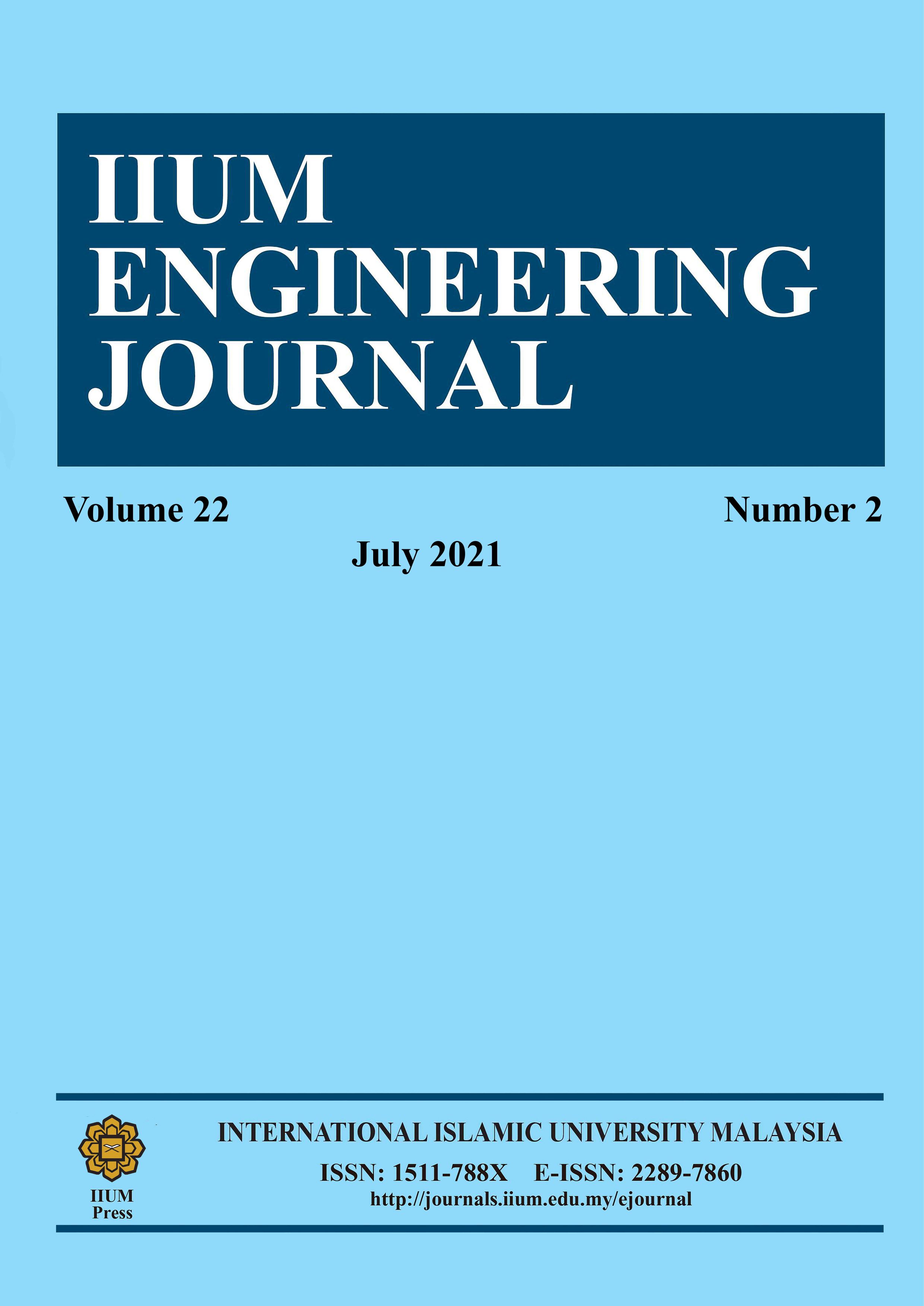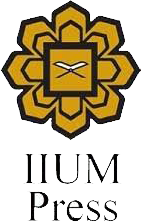MECHANICAL PROPERTIES, WATER ABSORPTION, AND FAILURE ANALYSES OF KENAF FIBER REINFORCED EPOXY MATRIX COMPOSITES
DOI:
https://doi.org/10.31436/iiumej.v22i2.1747Keywords:
Natural fiber, Kenaf composite, Mechanical properties.Abstract
The potential of natural fibers as one of the candidate materials in the production of fiber-reinforced polymer composites have been widely investigated. In the current study, natural fiber-reinforced polymer composite was fabricated by employing woven kenaf fiber as a reinforcing agent with epoxy resin that acts as a matrix constituent. This composite sample was fabricated using the application of the vacuum infusion method in which the content of kenaf fibers was varied from 30 vol.%, 40 vol.%, and 50 vol.%. The effects of different fiber loadings toward mechanical and physical properties as well as failure properties of kenaf composite were then evaluated. Kenaf composites were subjected to mechanical tests including tensile and flexural tests. The result shows that the highest tensile strength and modulus were attained at 76.67 MPa and 2.31 GPa, respectively with kenaf composite fabricated with 40 vol.% fiber content. Meanwhile, the highest flexural strength and modulus were recorded at 61.24 MPa and 4.20 GPa, also corresponding to kenaf composite that is loaded with 40 vol.% fibers. Fiber pull-out failure was able to be detected in fabricated kenaf composites. Meanwhile, fiber breakage resulting from flexural failure could also be observed in the kenaf composite samples. Apart from that, it was found that as more kenaf fiber was loaded in the composites, the rate of water absorption tended to increase where the highest rate of water absorption was found at 43.33%, displayed by kenaf composite with 50 vol.% of fiber content.
ABSTRAK: Potensi gentian semula jadi sebagai salah satu bahan dalam penghasilan komposit polimer bertetulang gentian telah banyak dikaji. Dalam kajian terkini, komposit polimer yang diperkuat dengan gentian semula jadi dibuat dengan menggunakan serat kenaf tenunan sebagai agen penguat dan resin epoksi yang bertindak sebagai matriks. Sampel komposit ini dibuat menggunakan kaedah infusi vakum di mana kandungan serat kenaf digunakan adalah 30 vol.%, 40 vol.%, dan 50 vol.%. Kesan kandungan serat yang berbeza terhadap sifat mekanikal dan fizikal serta sifat kegagalan komposit kenaf kemudiannya dinilai. Komposit Kenaf diuji dengan ujian tegangan dan lenturan. Hasilnya menunjukkan bahawa kekuatan tegangan dan modulus tertinggi dicapai pada 76.67 MPa dan 2.31 GPa, milik komposit kenaf yang dibuat dengan kandungan serat 40 vol.%. Sementara itu, kekuatan dan modulus lenturan tertinggi dicatatkan pada 61.24 MPa dan 4.20 GPa juga milik komposit kenaf yang dimuatkan dengan serat 40% vol. Kegagalan serat terkeluar dapat dikesan pada komposit kenaf buatan. Sementara itu, kerosakan serat akibat kegagalan lenturan juga dapat dilihat pada sampel komposit kenaf. Selain itu, didapati bahawa semakin banyak serat kenaf yang dimuatkan dalam komposit, cendurung meningkatkan kadar penyerapan air di mana kadar penyerapan air tertinggi didapati pada 43.33% yang ditunjukkan oleh komposit kenaf dengan kandungan serat 50% vol.
Downloads
Metrics
References
Saadati Y, Lebrun G, Chatelain JF and Beauchamp Y (2020) Experimental investigation of failure mechanisms and evaluation of physical/mechanical properties of unidirectional flax–epoxy composites. J. Composite Materials, 54(20): 1-21. doi:10.1177/0021998320902243 DOI: https://doi.org/10.1177/0021998320902243
Dhaliwal GS, Dueck SM, Newaz GM. (2019) Experimental and numerical characterization of mechanical properties of hemp fiber reinforced composites using multiscale analysis approach. SN Appl. Sci., 1: 1361. https://doi.org/10.1007/s42452-019-1383-6 DOI: https://doi.org/10.1007/s42452-019-1383-6
Madhu P, Sanjay MR, Senthamaraikannan P, Pradeep S, Saravanakumar SS and Yogesha B (2018) A review on synthesis and characterization of commercially available natural fibers: Part II. Journal of Natural Fibers, 16: 25-36. doi:10.1080/15440478.2018.1453433 DOI: https://doi.org/10.1080/15440478.2017.1379045
Thyavihalli Girijappa YG, Mavinkere Rangappa S, Parameswaranpillai J and Siengchin S (2019) Natural fibers as sustainable and renewable resource for development of eco-friendly composites: a comprehensive review. Frontiers in Materials, 6: 1-14. doi:10.3389/fmats.2019.00226 DOI: https://doi.org/10.3389/fmats.2019.00226
Mochane MJ, Mokhena TC, Mokhothu TH, Mtibe A, Sadiku ER, Ray SS, Ibrahim ID, Daramola OO (2019) Recent progress on natural fiber hybrid composites for advanced applications: A review. Express Polymer Letters, 13(2): 159-198. doi:10.3144/expresspolymlett.2019.15 DOI: https://doi.org/10.3144/expresspolymlett.2019.15
Siakeng R, Jawaid M, Ariffin H, Sapuan SM, Asim M and Saba N (2018) Natural fiber reinforced polylactic acid composites: A review. Polymer Composites, 40: 446-463. doi:10.1002/pc.24747 DOI: https://doi.org/10.1002/pc.24747
Navaneethakrishnan G, Karthikeyan, T, Saravanan S, Selvam V, Parkunam N, Sathishkumar G and Jayakrishnan S (2019) Structural analysis of natural fiber reinforced polymer matrix composite. Materials Today: Proceedings, 21: 7-9. doi:10.1016/j.matpr.2019.05.295 DOI: https://doi.org/10.1016/j.matpr.2019.05.295
Kumar R, Ul Haq MI, Raina A and Anand A (2018) Industrial applications of natural fibre-reinforced polymer composites – challenges and opportunities. International Journal of Sustainable Engineering, 12: 212-220. doi:10.1080/19397038.2018.1538267 DOI: https://doi.org/10.1080/19397038.2018.1538267
Javadian A, Smith Ian FC, Nazanin F and Hebel DE (2019) Mechanical properties of bamboo through measurement of culm physical properties for composite fabrication of structural concrete reinforcement. Frontiers in Materials, 6: 1-15. DOI: https://doi.org/10.3389/fmats.2019.00015
Gupta MK. (2018) Effect of variation in frequencies on dynamic mechanical properties of jute fibre reinforced epoxy composites. Journal of Materials and Environmental Sciences, 9: 100-106. https://doi.org/10.26872/jmes.2018.9.1.12 DOI: https://doi.org/10.26872/jmes.2018.9.1.12
Yang MFM, Hamid H, Abdullah AM. (2018) Potential use of cellulose fibre composites in marine environment - A Review. in: Öchsner A. (eds) Engineering Applications for New Materials and Technologies. Advanced Structured Materials, Springer, Cham, 86: 22-55. DOI: https://doi.org/10.1007/978-3-319-72697-7_3
Kaiser K, Schmid M, Schlummer M. (2017) Recycling of polymer-based multilayer packaging: A review. Recycling, 3: 1-26. doi:10.3390/recycling3010001 DOI: https://doi.org/10.3390/recycling3010001
Yuhazri MY, Amirhafizan MH, Abdullah A, Husin MA, Kamarul AM and Lau STW (2018) Kenaf fibre composites as promising green-composites for automotive car door map pocket application. International Journal of Mechanical & Mechatronics Engineering, 8: 15-21.
Cisneros-López EO, González-López ME, Pérez-Fonseca AA, González-Núñez R, Rodrigue D and Robledo-Ortíz JR (2016) Effect of fiber content and surface treatment on the mechanical properties of natural fiber composites produced by rotomolding. Composite Interfaces, 24: 35-53. doi:10.1080/09276440.2016.1184556 DOI: https://doi.org/10.1080/09276440.2016.1184556
Alberto M. (2013) Introduction of fibre-reinforced polymers ? Polymers and Composites: Concepts, Properties and Processes. Fiber Reinforced Polymers - The Technology Applied for Concrete Repair IntechOpen, pp. 3-40. DOI: https://doi.org/10.5772/54629
Harsha AP and Arjula S. (2010) Influence of fibre orientation on three-body abrasive wear behaviour of unidirectional carbon fibre-reinforced polyetherimide composite. Journal of Materials Science, 46: 983-991. doi:10.1007/s10853-010-4856-y DOI: https://doi.org/10.1007/s10853-010-4856-y
Adekomaya O, Jamiru T, Sadiku R and Huan Z (2017) Negative impact from the application of natural fibers. Journal of Cleaner Production, 143: 843-846. doi:10.1016/j.jclepro.2016.12.037 DOI: https://doi.org/10.1016/j.jclepro.2016.12.037
Wang W, Chouw N, Jayaraman K. (2016) Effect of thickness on the impact resistance of flax fibre-reinforced polymer. J. Reinforced Plastics and Composites, 35: 1277-1289. doi:10.1177/0731684416648780 DOI: https://doi.org/10.1177/0731684416648780
Peret T, Clement A, Freour S, Jacquemin F. (2019) Homogenization of Fickian and non-Fickian water diffusion in composites reinforced by hydrophobic long fibers: Application to the determination of transverse diffusivity. Composite Structures, 226: 1-9. doi:10.1016/j.compstruct.2019.111191 DOI: https://doi.org/10.1016/j.compstruct.2019.111191
Rozali NA, Abu Bakar MB, Masri MN, Sulaiman MA, Mohamed M, Ahmad Thirmizir MZ (2017) Mechanical and water absorption properties of hybrid kenaf/glass fibre mat reinforced unsaturated polyester composites. Materials Science Forum, 888: 228-233. doi:10.4028/www.scientific.net/msf.888.228 DOI: https://doi.org/10.4028/www.scientific.net/MSF.888.228
Maslinda AB, Abdul Majid MS, Ridzuan MJM, and Syayuthi ARA (2017). Water absorption behaviour of hybrid interwoven cellulosic fibre composites. IOP Conf. Series: Journal of Physics: Conf. Series, 908: 012015. doi:10.1088/1742-6596/908/1/012015 DOI: https://doi.org/10.1088/1742-6596/908/1/012015
Downloads
Published
How to Cite
Issue
Section
License
Copyright (c) 2021 IIUM Press

This work is licensed under a Creative Commons Attribution-NonCommercial 4.0 International License.






















